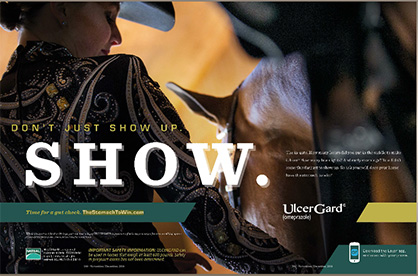Could You be Missing the Signs of Equine Ulcers?
 Behavior and performance changes may prompt further investigation.
Behavior and performance changes may prompt further investigation.
Sometimes a training ride or a show doesn’t go well. You wonder, “Is my horse just having a bad day?” Equestrians are often quick to place blame on a variety of causes, from the weather and the environment to the horse’s athletic ability or even their own riding errors. One potential cause to consider – equine stomach ulcers.
Less-than-optimal performance, resistance to work and difficulty training are all common issues that may be associated with gastric ulcers1,2 which can develop in as few as five days.3 If you have noticed behaviors such as your horse pinning his ears while being groomed, or kicking out when the girth is tightened, equine stomach ulcers could be a possibility, and it may be time to contact your veterinarian.
“When horses are having behavioral issues or even decreased performance in the show ring, riders and trainers should consider stomach ulcers,” says Hoyt Cheramie, DVM, MS, DACVS, Senior Equine Professional Service Veterinarian, Boehringer Ingelheim. “An equine veterinarian will be able to diagnose ulcers via gastroscopy.”
Because ulcers can’t be seen with the naked eye, gastroscopy is the only way to definitively diagnose stomach ulcers.4 The exam provides the extra benefit of allowing your veterinarian to assess current stomach conditions and, if ulcers are present, grade them. Your veterinarian will examine several parts of the stomach in search of anything abnormal, such as ulcerations, erosions, reddening, thickening, abnormal coloring and sometimes parasites such as bot larvae. He or she will also note where the stomach ulcers are located – in the squamous area or the glandular area.
Squamous ulcers are the most common, and are found in the upper part of the stomach, as this part of the stomach has a thinner lining that isn’t protected from the stomach acid.5 If your veterinarian finds any squamous ulcers, he or she will grade them according to severity and take photos or videos to document them for comparison after treatment.
“Horse owners are sometimes very surprised at the exam findings,” Cheramie says. “This is why gastroscopy is so useful – to truly know what’s going on inside the horse’s stomach so the veterinarian can diagnose the ulcers and prescribe appropriate treatment.”
The stress of training, showing and traveling, along with the way horses are commonly fed and managed, can contribute to the development of ulcers. If your horse is diagnosed with ulcers, treatment with Gastrogard®(omeprazole) may be recommended. GASTROGARD is the only proven and FDA-approved ulcer treatment product. It contains specially formulated omeprazole that suppresses acid production to a level that allows the ulcers to heal.6
In addition to treatment with medication, Cheramie suggests the following as part of ulcer management:
- Provide continuous access to roughage through grazing or hay-restrictive feeders or nets
- Feed grain divided into multiple small meals daily
- Work with your veterinarian to make other management adjustments as warranted
In addition to the recommendations listed above, Cheramie suggests giving Ulcergard® (omeprazole), an FDA-approved and proven ulcer prevention medication, during times of stress.7 ULCERGARD, with its patented formulation, ensures the medication is protected and available for absorption and will help protect your horse’s stomach lining.
Having a horse develop a change in attitude or resistance to work can be challenging for any equestrian. If your horse exhibits signs that may be associated with ulcers, don’t let him suffer. Contact your veterinarian to diagnose, treat and prevent ulcers appropriately.
IMPORTANT SAFETY INFORMATION: ULCERGARD can be used in horses that weigh at least 600 pounds. Safety in pregnant mares has not been determined.
Caution: Safety of GASTROGARD in pregnant or lactating mares has not been determined.
Click here for prescribing information.
About Boehringer Ingelheim Animal Health
As the second largest animal health business in the world, Boehringer Ingelheim is committed to improving animal health. With more than 10,000 employees worldwide, Boehringer Ingelheim Animal Health has products available in more than 150 markets and a global presence in 99 countries. For more information about Boehringer Ingelheim Animal Health, click here.
Boehringer Ingelheim
Innovative medicines for people and animals have for more than 130 years been what the research-driven pharmaceutical company Boehringer Ingelheim stands for. Boehringer Ingelheim is one of the industry’s top 20 pharmaceutical companies and to this day remains family-owned. Day by day, some 50,000 employees create value through innovation for the three business areas human pharmaceuticals, animal health and biopharmaceutical contract manufacturing. In 2016, Boehringer Ingelheim achieved net sales of around 15.9 billion euros. With more than three billion euros, R&D expenditure corresponds to 19.6 per cent of net sales.
Social responsibility comes naturally to Boehringer Ingelheim. That is why the company is involved in social projects, such as the “Making More Health” initiative. Boehringer Ingelheim also actively promotes workforce diversity and benefits from its employees’ different experiences and skills. Furthermore, the focus is on environmental protection and sustainability in everything the company does.
More information about Boehringer Ingelheim can be found on www.boehringer-ingelheim.com or in our annual report: http://annualreport.boehringer-ingelheim.com.
GASTROGARD and ULCERGARD are Merial products. Merial is now part of Boehringer Ingelheim.
®GASTROGARD and ULCERGARD are registered trademarks of Merial. ©2018 Merial, Inc., Duluth, GA. All rights reserved. EQU-0610-EGUS0418.
1Mitchell RD. Prevalence of gastric ulcers in hunter/jumper and dressage horses evaluated for poor performance. Association for Equine Sports Medicine, September 2001.
2Equine Gastric Ulcer Council. Recommendations for the diagnosis and treatment of Equine Gastric Ulcer Syndrome (EGUS). Equine Vet Educ. 1999;11:262-272.
3McClure SR, Carithers DS, Gross SJ, Murray MJ. Gastric ulcer development in horses in a simulated show or training environment. J Am Vet Med Assoc. 2005;227(5):775-777.
4McClure S. AAEP Equine Gastric Ulcers: Special Care and Nutrition. Available at: http://www.aaep.org/info/horse-health?publication=817. Accessed January 4, 2016.
5Nieto J. Diagnosing and Treating Gastric Ulcers in Horses. CEH Horse Report. Accessed January 4, 2016, from http://www.vetmed.ucdavis.edu/ceh/local_resources/pdfs/pubs-Oct2012-sec.pdf.
6GASTROGARD product label.
7ULCERGARD product label.










